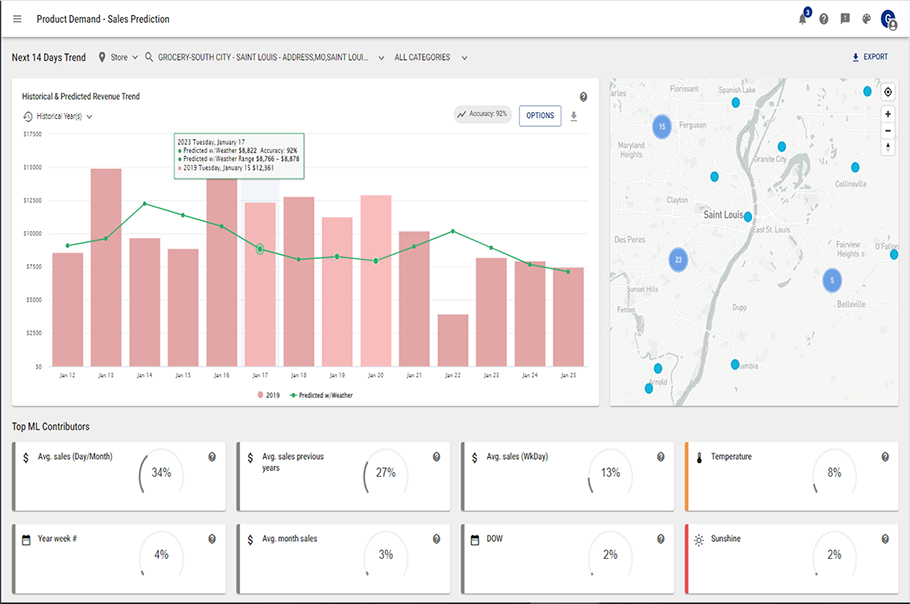Here at Weather Source 2023 is already busier than ever, but we certainly aren’t resting on our laurels. We are tackling the biggest and most pressing weather issues and challenges that have made us a market leader and innovator.
As you know Weather Source is constantly innovating and developing novel weather products and solutions, so before we get too far into the year, we wanted to take a few minutes and let you know about some of our new product and feature updates.
Weather Insights Platform (WIP)
Our newest release, the Weather Insights Platform (WIP) is a machine learning demand forecast tool focusing on the retail and restaurant industry and it’s already being used in full production by several retailers! Weather Source, in tandem with our parent company Pelmorex, debuted WIP at the National Retail Federation’s “Big Show” in January. The “Big Show” is the retail industry’s largest trade show and WIP was well received by the many attendees representing a wide variety of companies.
WIP is a SaaS based application that provides businesses a product demand forecast down to the SKU and store level. WIP generates insights and weather impacts by showing how product sales correlate to weather. In addition, WIP provides sales demand forecasts, compares prior year’s sales and weather to present and initiates weather-triggered promotions, just to name a few of its many features.
WIP is built in the cloud with a highly configurable, modular and scalable design that is easily deployed in any cloud instance or customer infrastructure. Powered by Weather Source and Pelmorex cutting edge technology, WIP provides highly accurate demand forecast models covering hours, days, weeks, months and even up to a year using climatology data. (note: A sample image of the WIP dashboard is pictured above.)
HRRR
HRRR stands for “High-Resolution Rapid Refresh,” which is a high-resolution weather model built upon NCEP (National Centers for Environmental Prediction) and the GFS forecast. The HRRR model is designed to provide short-term, high-resolution weather forecasts, with a focus on convective storms, winter weather, and other high-impact weather events.
Unlike other forecast models that are released every six hours, the HRRR model is initialized and refreshed every hour. With a native resolution of 3 kilometers and temporal resolution of 15 minutes, HRRR has two forecast views: (i) an 18 hour forward forecast view that is refreshed hourly; and (ii) a forward forecast view going out 48 hours that is refreshed every six hours. This high spatial and temporal resolution allows for more accurate forecasts of weather phenomena that occur on smaller scales, such as thunderstorms, snow squalls, hail, precipitation and with the 15-minute temporal resolution, businesses are able to make “game-day” decisions
The HRRR model incorporates data from a wide variety of sources, including satellite and radar data, surface observations, and atmospheric soundings. It also uses advanced numerical algorithms to simulate the behavior of the atmosphere, taking into account the effects of moisture, temperature, wind, and other variables. The HRRR model is an important tool for meteorologists, energy and utility companies, emergency responders and those who need to access a high skill score short range forecast for high-impact weather events.
Dynamic Elevation Adjustment
The concept of elevation adjustment is unique to Weather Source and dynamically resolves differences in elevation between the elevation of a location of interest and the elevation of the interpolating weather inputs. Dynamic Elevation Adjustment is necessary because weather conditions can vary significantly with changes in elevation and accurate weather forecasting requires data that is representative of the actual conditions at a given location.

For example, the temperature at the base of a mountain (i.e., where weather sensing inputs may be located) may be different from the temperature at the top of the mountain due to changes in altitude (i.e., temperature inversions) even if the locations are geographically close.
Dynamic elevation adjustment is important for a wide range of applications, including wind farms or solar arrays that are located at the top of a ride line, roadways that navigate during mountainous terrain, agriculture, and aviation. It allows for more accurate predictions and better decision-making.
GFS and ECMWF Ensembles
Weather Source processes all of the forecast ensemble members (31 for GFS and 51 for ECMWF) in real-time providing users the ability to create business intelligence around the spread of the distributions of the ensembles to better understand the potential variances of each forecast. This can be very useful not only for scenario planning but also to also to understand the confidence level in the forecast skill.
Weather Source processes these ensembles in real-time and offers not only the “raw” ensemble data but also the statistical summary of the distribution of the ensembles as both deciles and terciles, which allow a user to ascertain if there is a bi-modal distribution of the ensembles (i.e., potential variances in the forecast) or are they tightly wound around the forecast mean (i.e., indicates a high level of confidence in the skill of the forecast).
Historical Forecasts
As historical data is essential to understand the future, Weather Source also provides Historical Forecast Data. These databases are a stable source of historical information because once the data is archived no changes or edits are made. This pristine data is available in the following formats: (i) GFS back to January 2015, (ii) ECMWF Short/Mid historical forecast data back to July 1, 2017, and (iii) ECMWF Long-Range forecast data back to January 1, 2014. Seasonal forecast data is also available.
ECMWF Seasonal Forecasts
Weather Source offers both seasonal and sub-seasonal forecasts from the ECMWF which go out in six weekly increments or monthly views going out up to seven months. ECMWF seasonal forecasts are long-range forecasts that predict how the climate will evolve over a period of several months. These forecasts are based on the same numerical weather prediction models used for short-term forecasts, but they are run for much longer periods of time and with different initialization conditions.
ECMWF seasonal forecasts use a state-of-the-art coupled ocean-atmosphere model, which takes into account interactions between the ocean and atmosphere, as well as other factors that can influence the climate, such as sea ice, land surface processes, and greenhouse gasses. The model is run multiple times with slightly different initial conditions to generate a range of possible outcomes, which are then presented as probability distributions.
ECMWF seasonal forecasts can be used for a range of applications, including agriculture, energy, water management, and disaster risk reduction. For example, a seasonal forecast that predicts a dry spell in a particular region can help farmers decide what crops to plant, while a forecast that predicts above-average temperatures can help energy providers prepare for increased demand for cooling.



